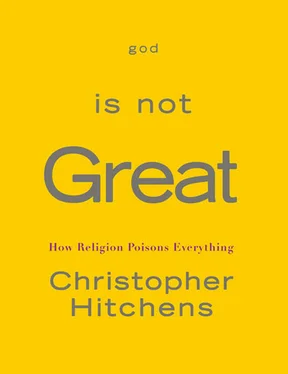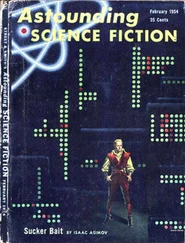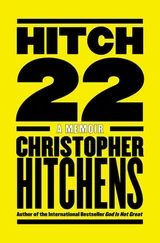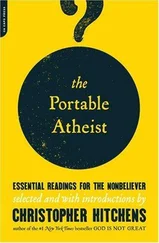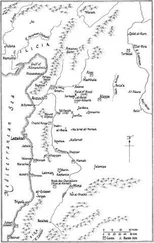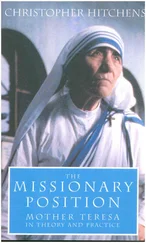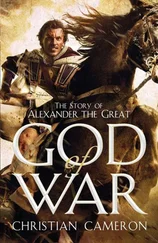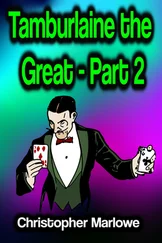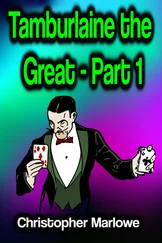The blood continued to rise. Millions of birds flocked into the area and feasted on the remains… and the winepress was trampled outside the city, and blood came out of the winepress, up to the horse’s bridles, for one thousand six hundred furlongs.
This is sheer manic relish, larded with half-quotations. More reflectively, but hardly less regrettably, it can be found in Julia Ward Howe’s “Battle Hymn of the Republic,” which dwells on the same winepress, and in Robert Oppenheimer’s murmur as he watched the first nuclear detonation at Alamagordo, New Mexico, and heard himself quoting the Hindu epic the Bhagavad Gita: “I am become Death, the destroyer of worlds.” One of the very many connections between religious belief and the sinister, spoiled, selfish childhood of our species is the repressed desire to see everything smashed up and ruined and brought to naught. This tantrum-need is coupled with two other sorts of “guilty joy,” or, as the Germans say, schadenfreude . First, one’s own death is canceled—or perhaps repaid or compensated—by the obliteration of all others. Second, it can always be egotistically hoped that one will be personally spared, gathered contentedly to the bosom of the mass exterminator, and from a safe place observe the sufferings of those less fortunate. Tertullian, one of the many church fathers who found it difficult to give a persuasive account of paradise, was perhaps clever in going for the lowest possible common denominator and promising that one of the most intense pleasures of the afterlife would be endless contemplation of the tortures of the damned. He spoke more truly than he knew in evoking the man-made character of faith.
As in all cases, the findings of science are far more awe-inspiring than the rantings of the godly. The history of the cosmos begins, if we use the word “time” to mean anything at all, about twelve billion years ago. (If we use the word “time” wrongly, we shall end up with the infantile computation of the celebrated Archbishop James Ussher of Armagh, who calculated that the earth—“the earth” alone, mind you, not the cosmos—had its birthday on Saturday, October 22, in 4004 BC, at six in the afternoon. This dating was endorsed by William Jennings Bryan, a former American secretary of state and two-time Democratic presidential nominee, in courtroom testimony in the third decade of the twentieth century.) The true age of the sun and its orbiting planets—one of them destined to harbor life and all the others doomed to lifelessness—is perhaps four and a half billion years and subject to revision. This particular microscopic solar system most probably has at least that long again to run its fiery course: the life expectancy of our sun is a solid five billion more years. However, mark your calendar. At around that point, it will emulate millions of other suns and explosively mutate into a swollen “red giant,” causing the earth’s oceans to boil and extinguishing all possibility of life in any form. No description by any prophet or visionary has even begun to picture the awful intensity and irrevocability of that moment. One has at least some pitiful self-centered reason not to fear undergoing it: on current projections the biosphere will very probably have been destroyed by different and slower sorts of warming and heating in the meantime. As a species on earth, according to many sanguine experts, we do not have many more eons ahead of us.
With what contempt and suspicion, then, must one regard those who are not willing to wait, and who beguile themselves and terrify others—especially the children, as usual—with horrific visions of apocalypse, to be followed by stern judgment from the one who supposedly placed us in this inescapable dilemma to begin with. We may laugh now at the foam-flecked hell-and-damnation preachers who loved to shrivel young souls with pornographic depictions of eternal torture, but this phenomenon has reappeared in a more troubling form with the holy alliance between the believers and what they can borrow or steal from the world of science. Here is Professor Pervez Hoodbhoy, a distinguished professor of nuclear and high-energy physics at the University of Islamabad in Pakistan, writing about the frightening mentality which prevails in his country—one of the world’s first states to define its very nationality by religion:
In a public debate on the eve of the Pakistani nuclear tests, the former chief of the Pakistani army General Mirza Aslam Beg said: “We can make a first strike and a second and even a third.” The prospect of nuclear war left him unmoved. “You can die crossing the street,” he said, “or you could die in a nuclear war. You’ve got to die someday, anyway.” … India and Pakistan are largely traditional societies, where the fundamental belief structure demands disempowerment and surrender to larger forces. A fatalistic Hindu belief that the stars above determine our destiny, or the equivalent Muslim belief in kismet certainly account for part of the problem.
I shall not disagree with the very brave Professor Hoodbhoy, who helped alert us to the fact that there were several secret bin Laden supporters among the bureaucrats of the Pakistani nuclear program, and who also exposed the wild fanatics within that system who hoped to harness the power of the mythical djinns , or desert devils, for military purposes. In his world, the enemies are mainly Muslims and Hindus. But within the “Judeo-Christian” world also, there are those who like to fantasize about a final conflict and embellish the vision with mushroom-shaped clouds. It is a tragic and potentially lethal irony that those who most despise science and the method of free inquiry should have been able to pilfer from it and annex its sophisticated products to their sick dreams.
The death wish, or something not unlike it, may be secretly present in all of us. At the turn of the year 1999 into 2000, many educated people talked and published infinite nonsense about a series of possible calamities and dramas. This was no better than primitive numerology: in fact it was slightly worse in that 2000 was only a number on Christian calendars and even the stoutest defenders of the Bible story now admit that if Jesus was ever born it wasn’t until at least AD 4. The occasion was nothing more than an odometer for idiots, who sought the cheap thrill of impending doom. But religion makes such impulses legitimate, and claims the right to officiate at the end of life, just as it hopes to monopolize children at life’s beginning. There can be no doubt that the cult of death and the insistence upon portents of the end proceed from a surreptitious desire to see it happen, and to put an end to the anxiety and doubt that always threaten the hold of faith. When the earthquake hits, or the tsunami inundates, or the twin towers ignite, you can see and hear the secret satisfaction of the faithful. Gleefully they strike up: “You see, this is what happens when you don’t listen to us!” With an unctuous smile they offer a redemption that is not theirs to bestow and, when questioned, put on the menacing scowl that says, “Oh, so you reject our offer of paradise? Well, in that case we have quite another fate in store for you.” Such love! Such care!
The element of the wish for obliteration can be seen without disguise in the millennial sects of our own day, who betray their selfishness as well as their nihilism by announcing how many will be “saved” from the ultimate catastrophe. Here the extreme Protestants are almost as much at fault as the most hysterical Muslims. In 1844, one of the greatest American religious “revivals” occurred, led by a semiliterate lunatic named George Miller. Mr. Miller managed to crowd the mountaintops of America with credulous fools who (having sold their belongings cheap) became persuaded that the world would end on October 22 that year. They removed themselves to high ground—what difference did they expect that to make?—or to the roofs of their hovels. When the ultimate failed to arrive, Miller’s choice of terms was highly suggestive. It was, he announced, “The Great Disappointment.” In our own time, Mr. Hal Lindsey, author of the best-selling The Late Great Planet Earth , has betrayed the same thirst for extinction. Indulged by senior American conservatives and respectfully interviewed on TV, Mr. Lindsey once dated the start of “The Tribulation”—a seven-year period of strife and terror—for 1988. This would have produced Armageddon itself (the closure of “The Tribulation”) in 1995. Mr. Lindsey may be a charlatan, but it is a certainty that he and his followers suffer from a persistent feeling of anticlimax.
Читать дальше
